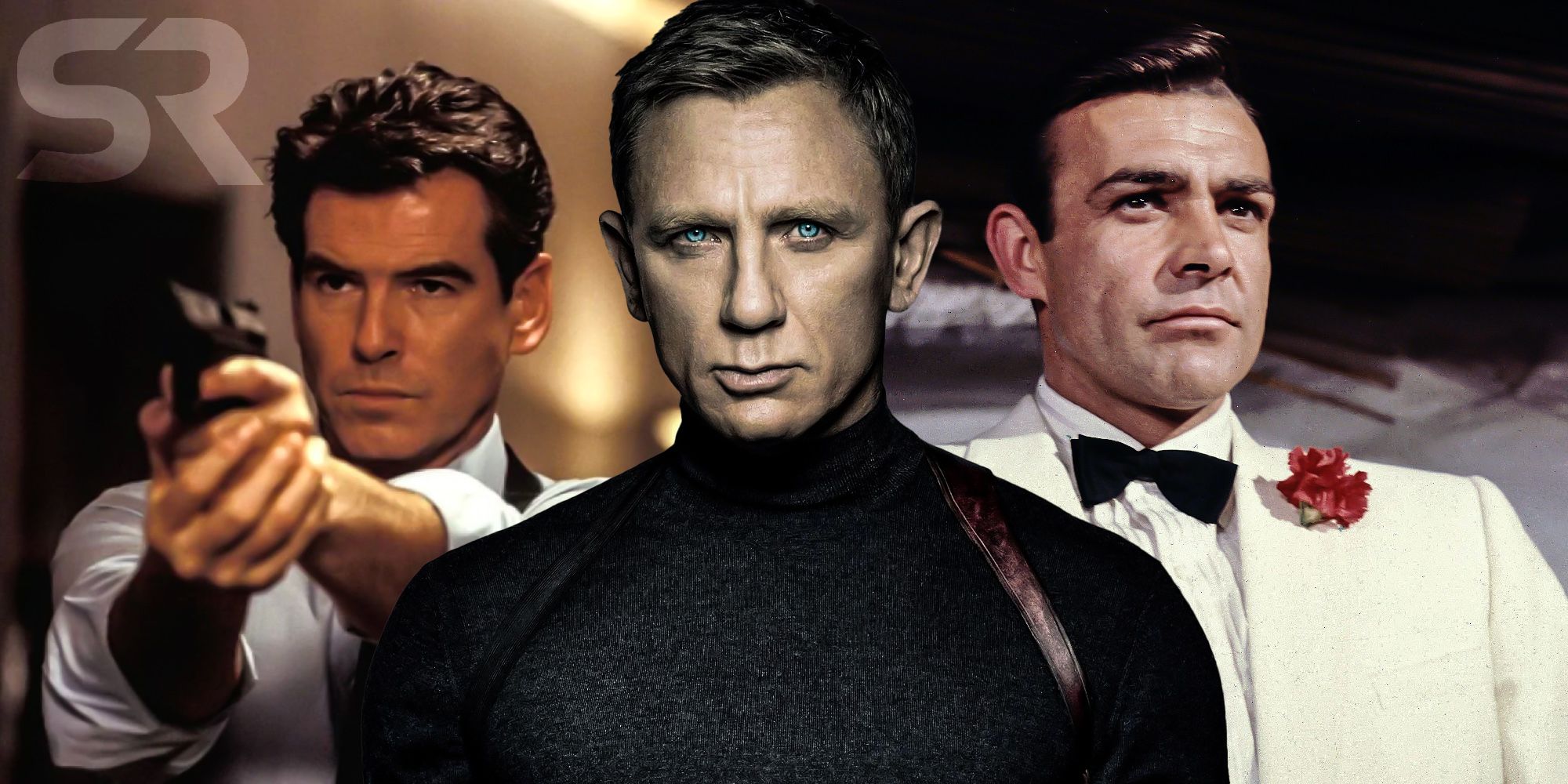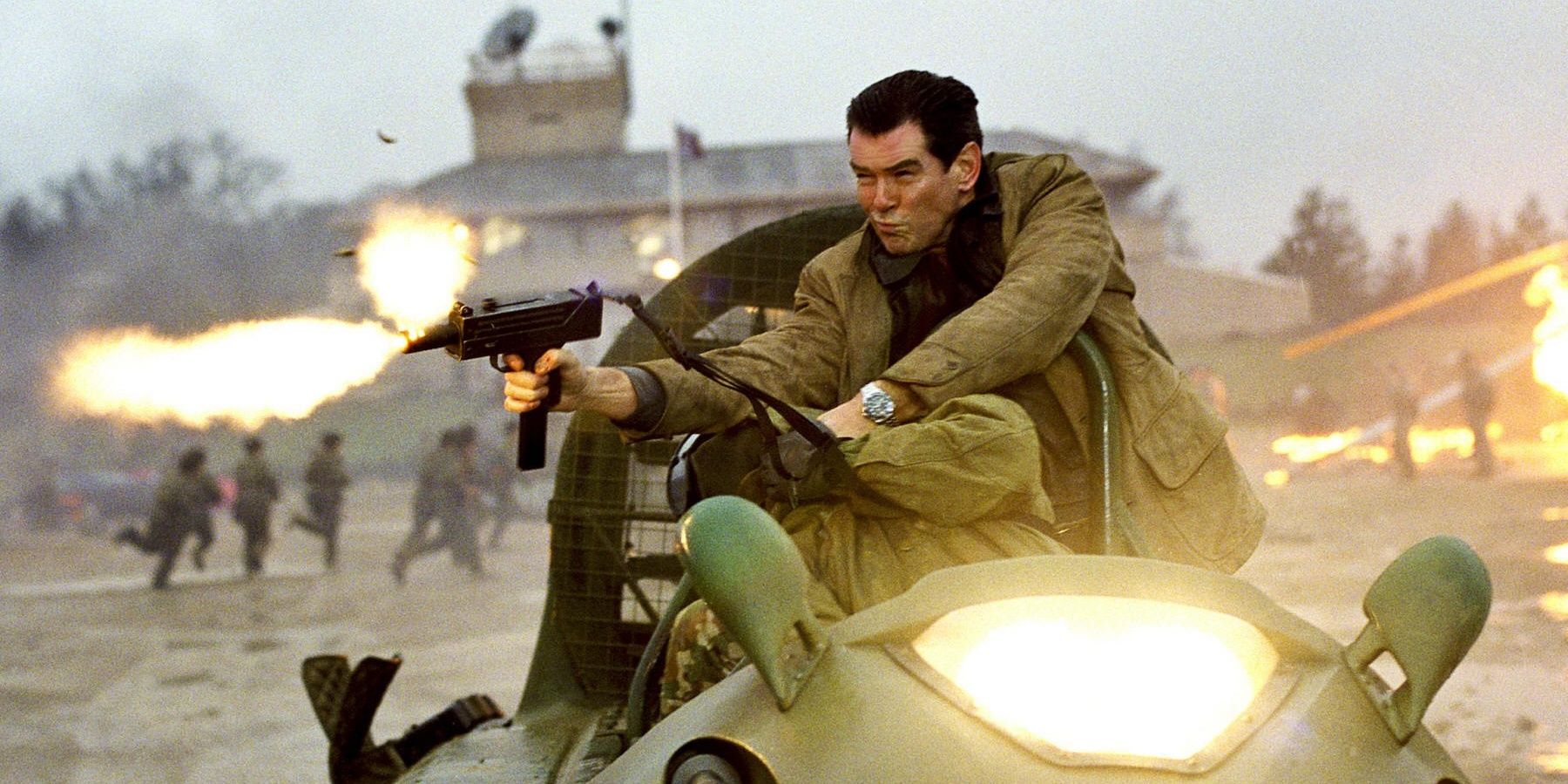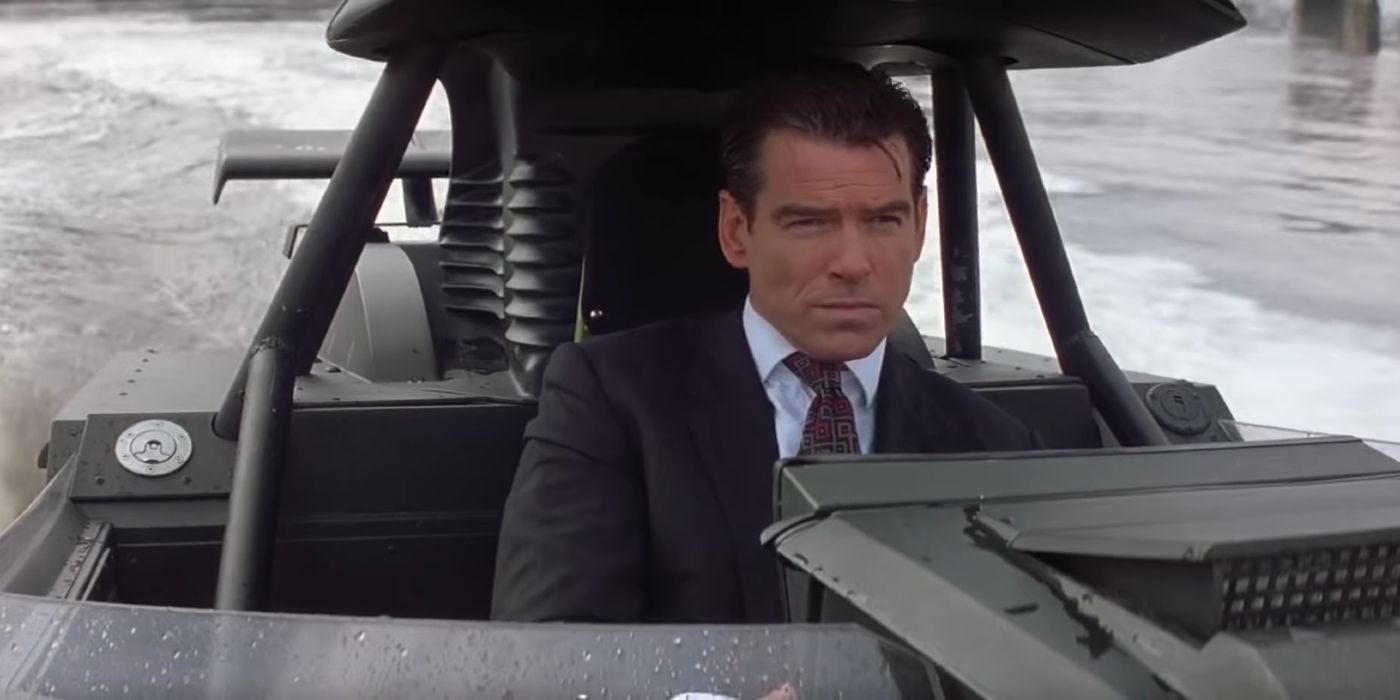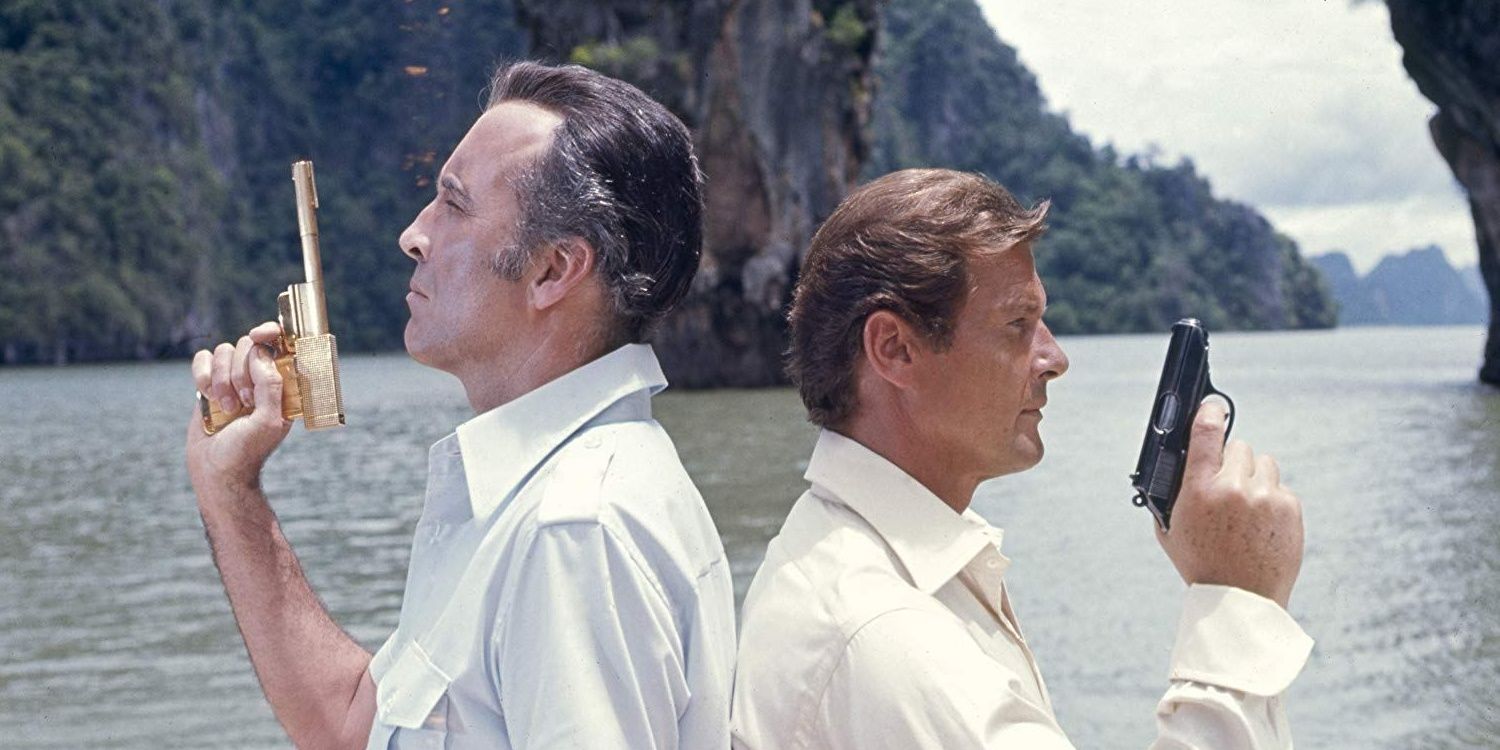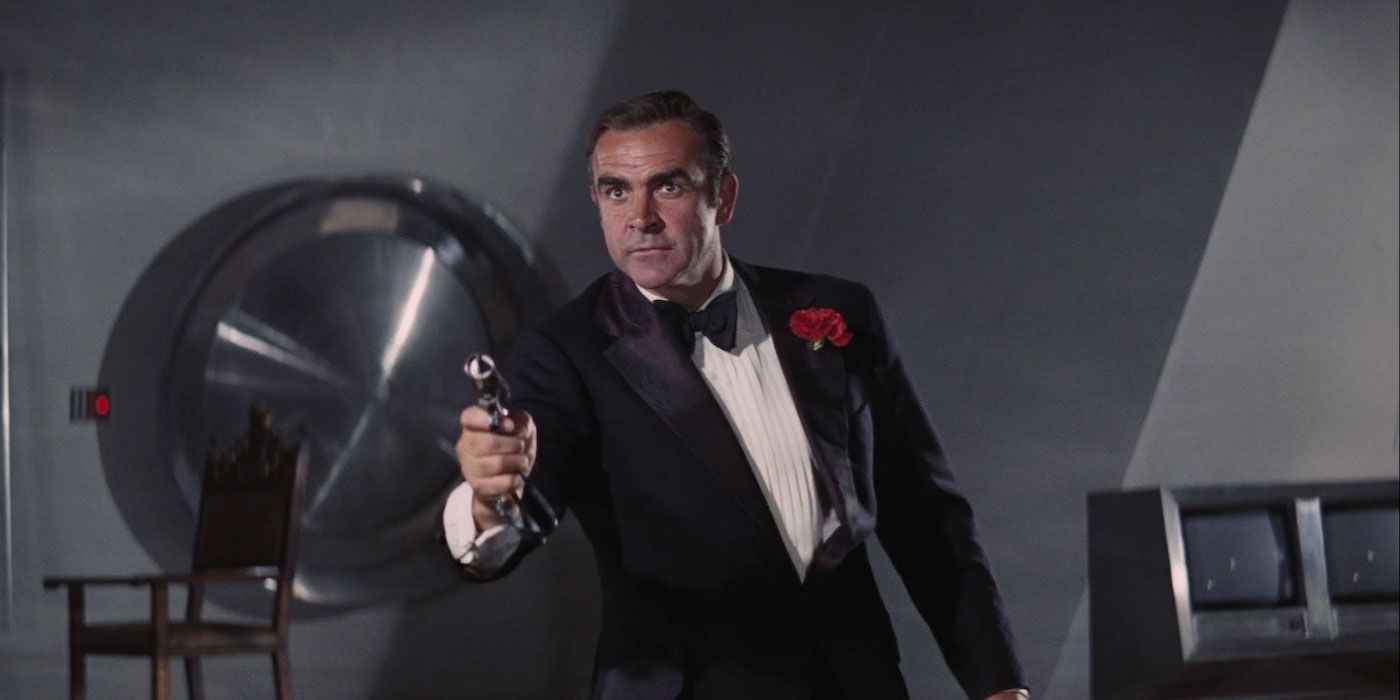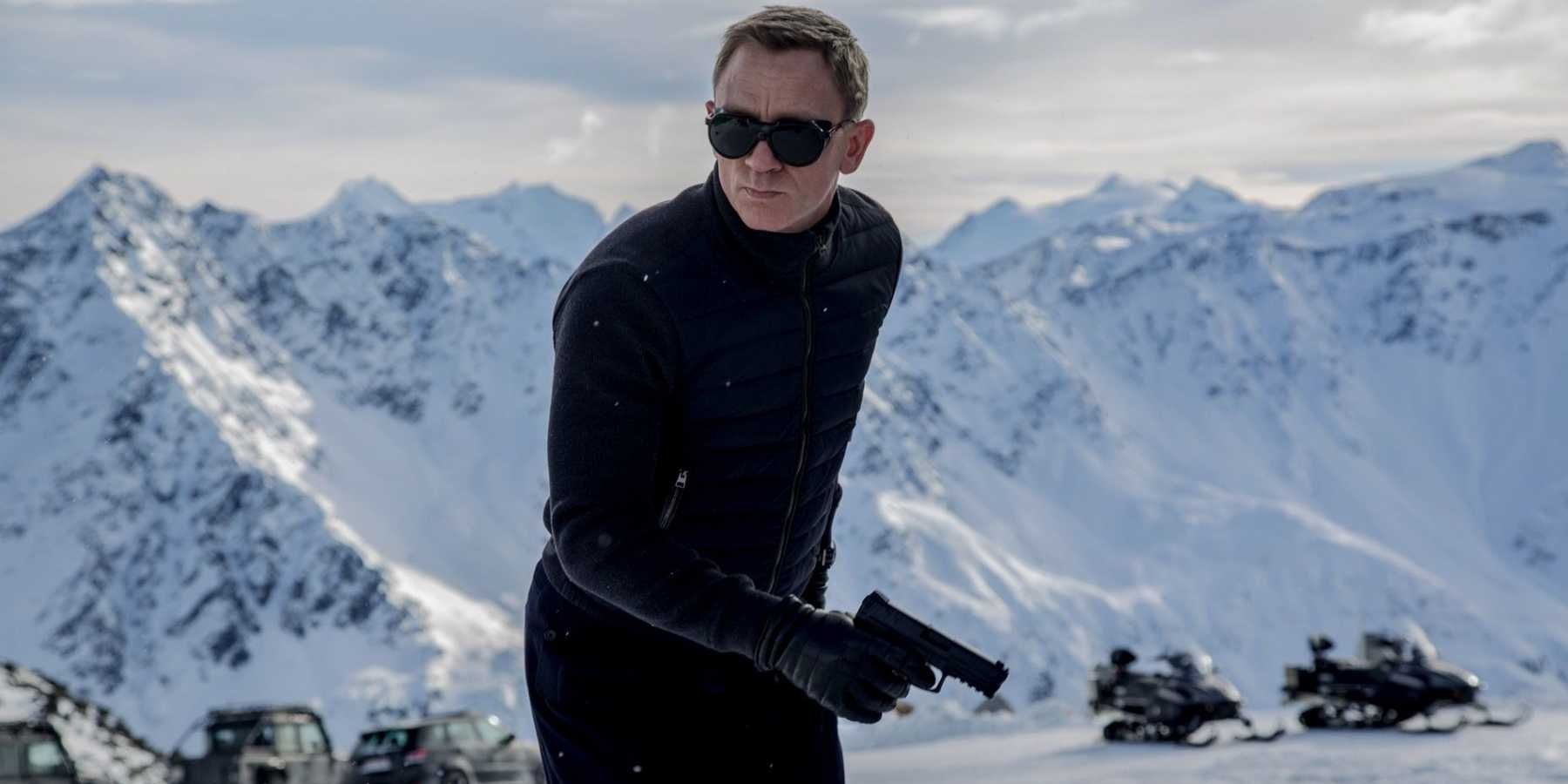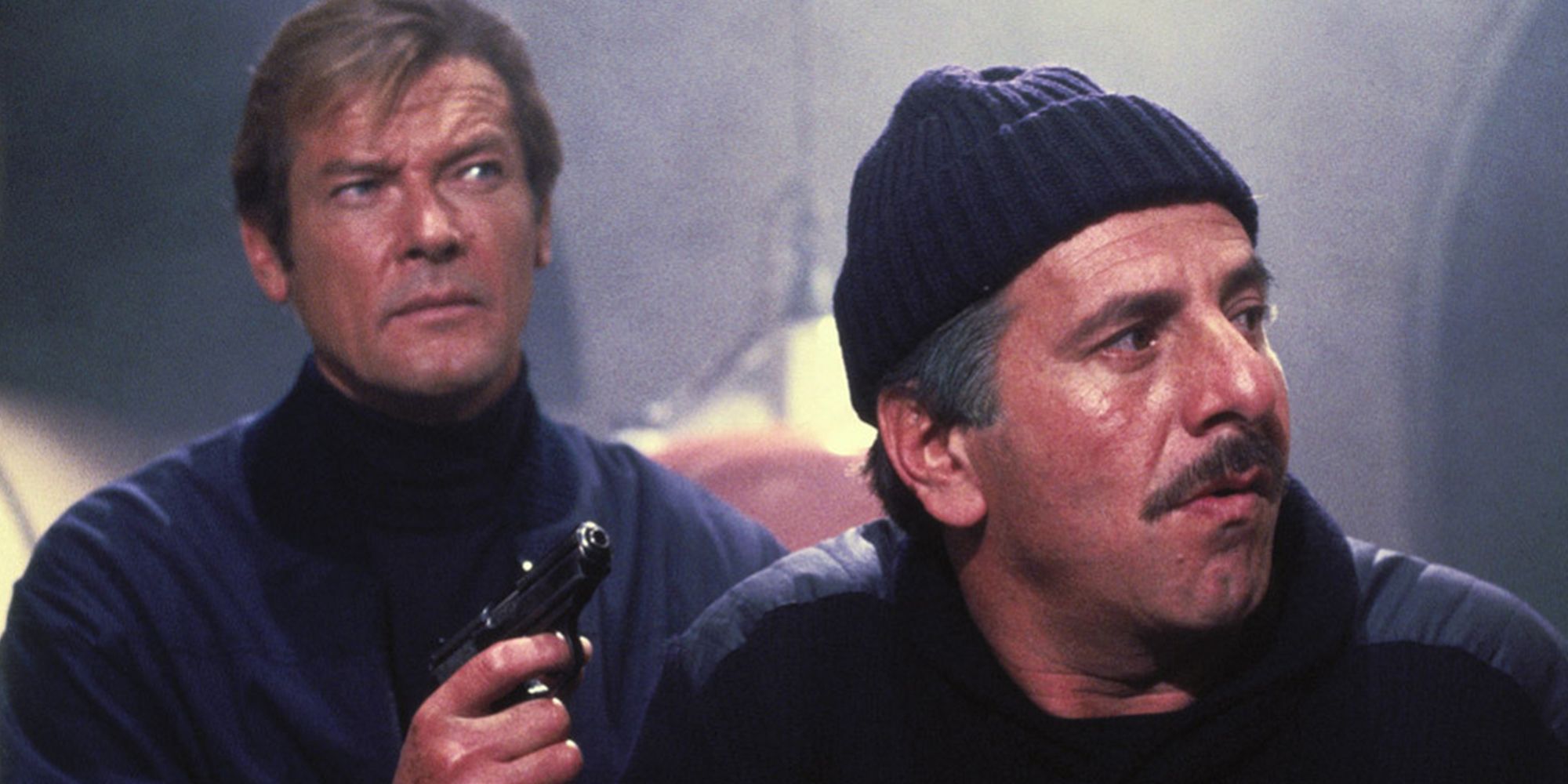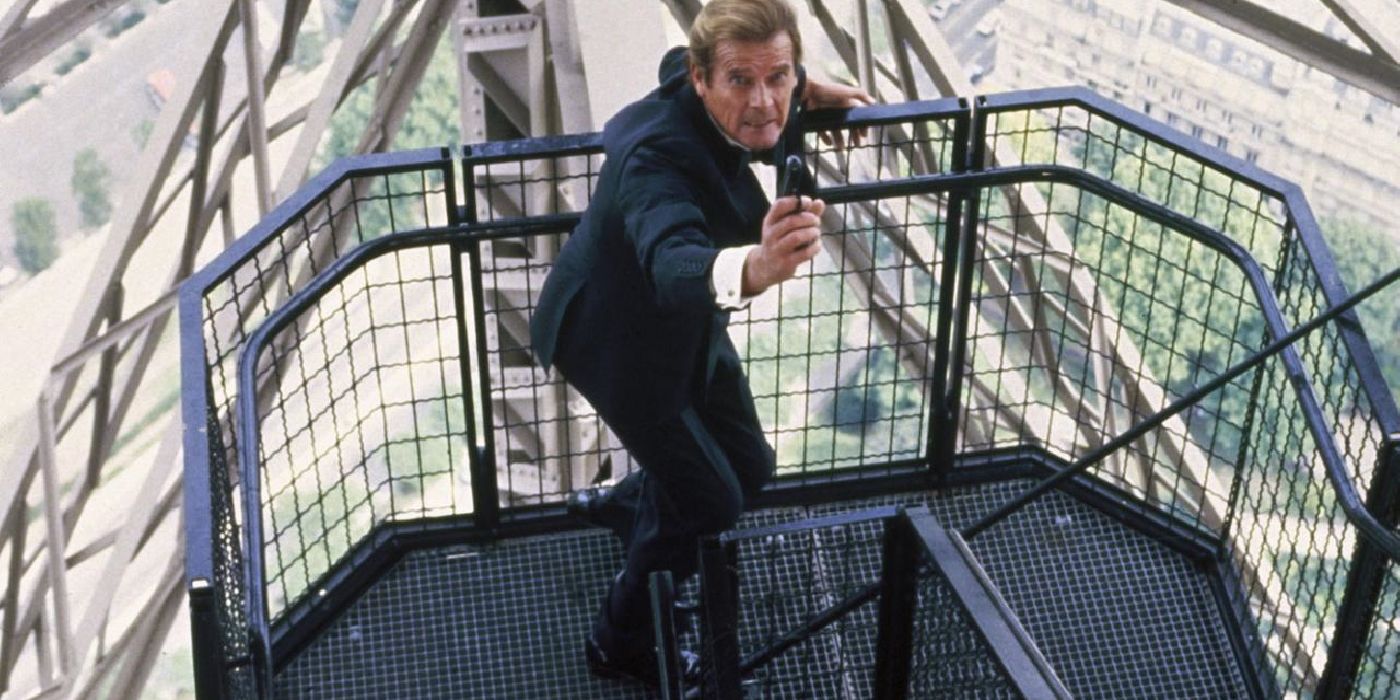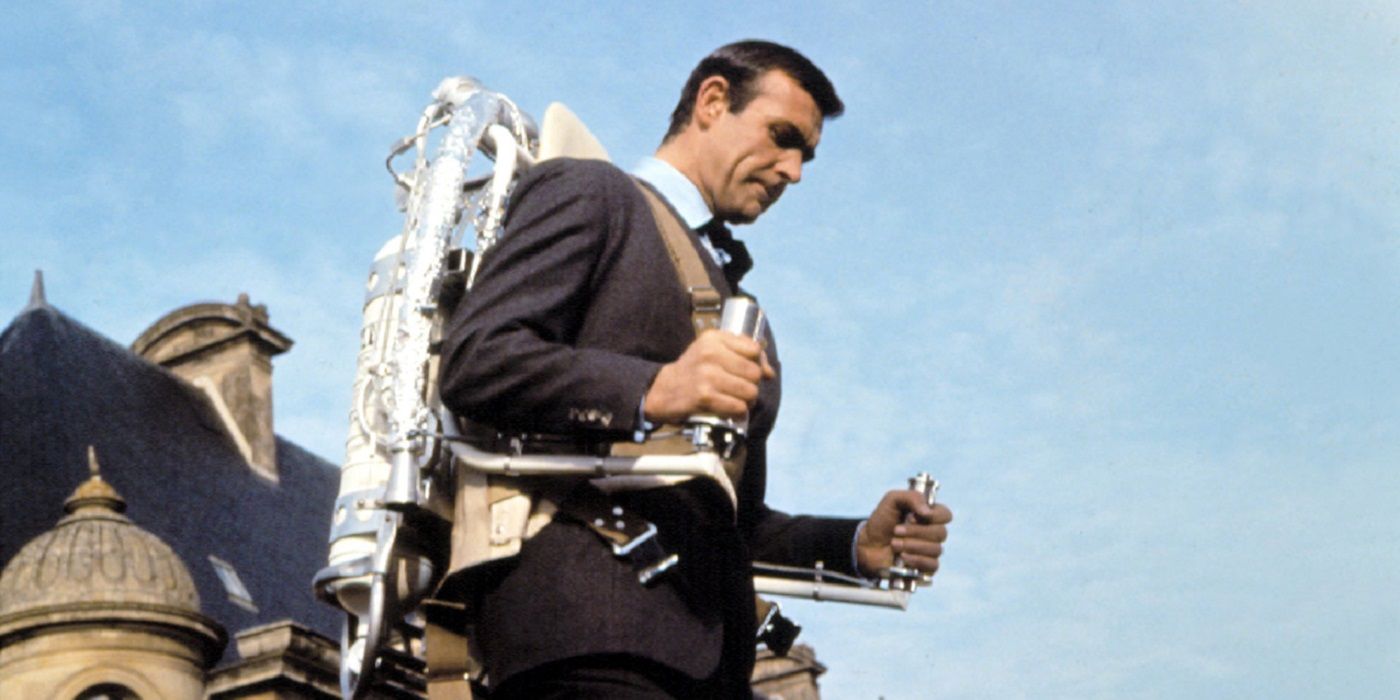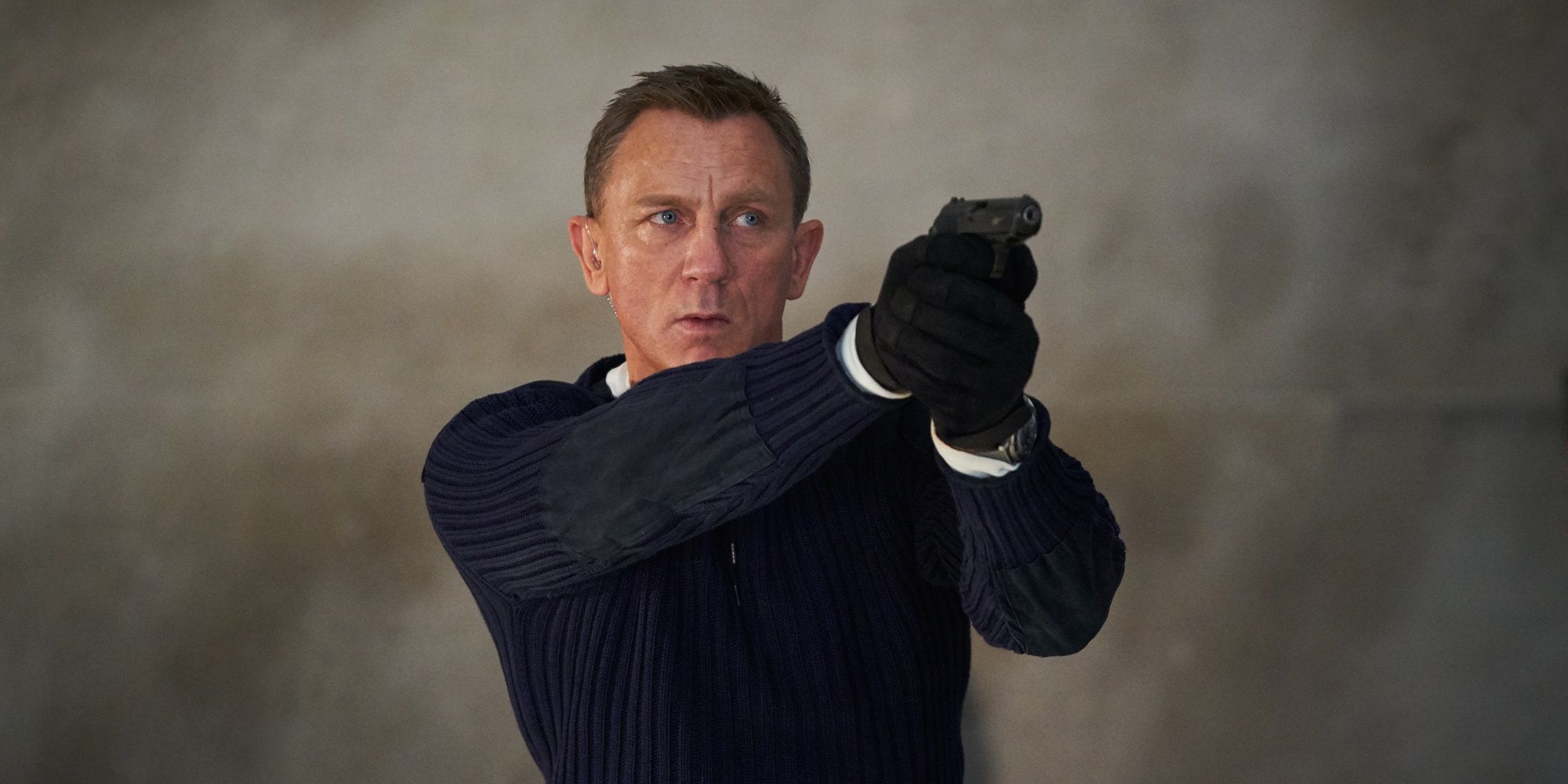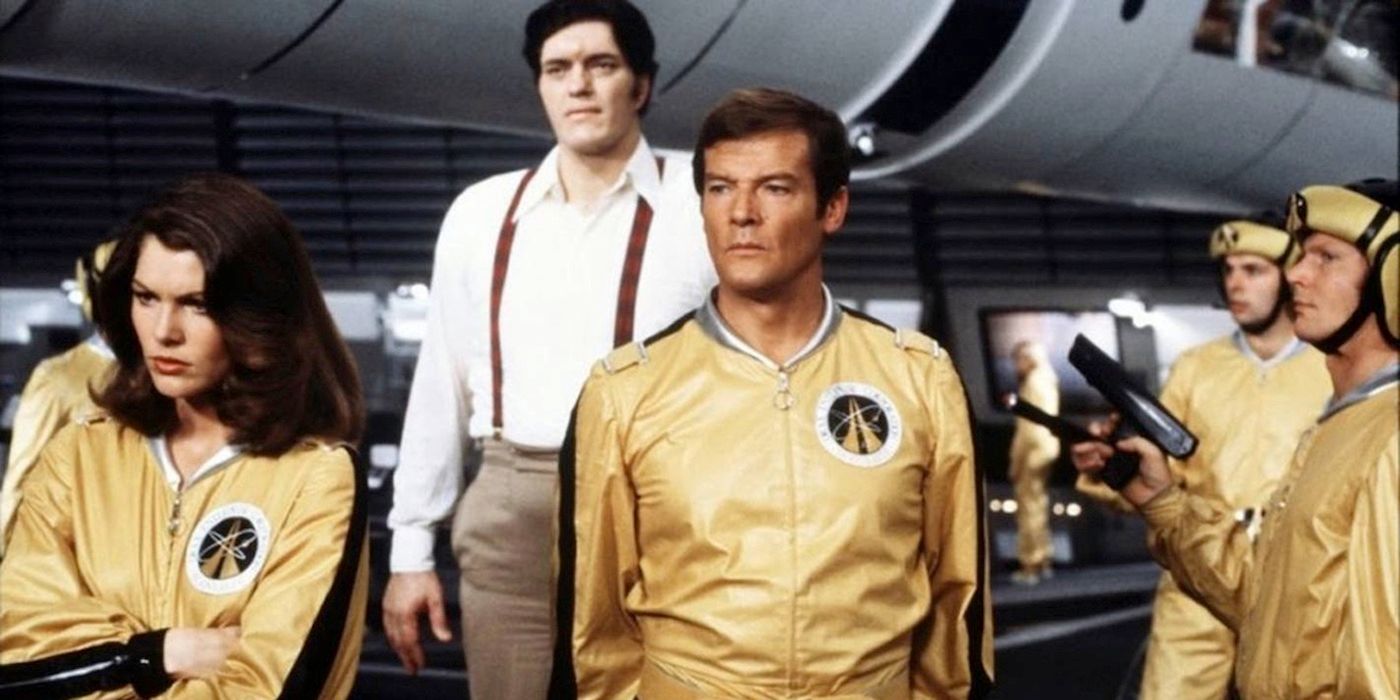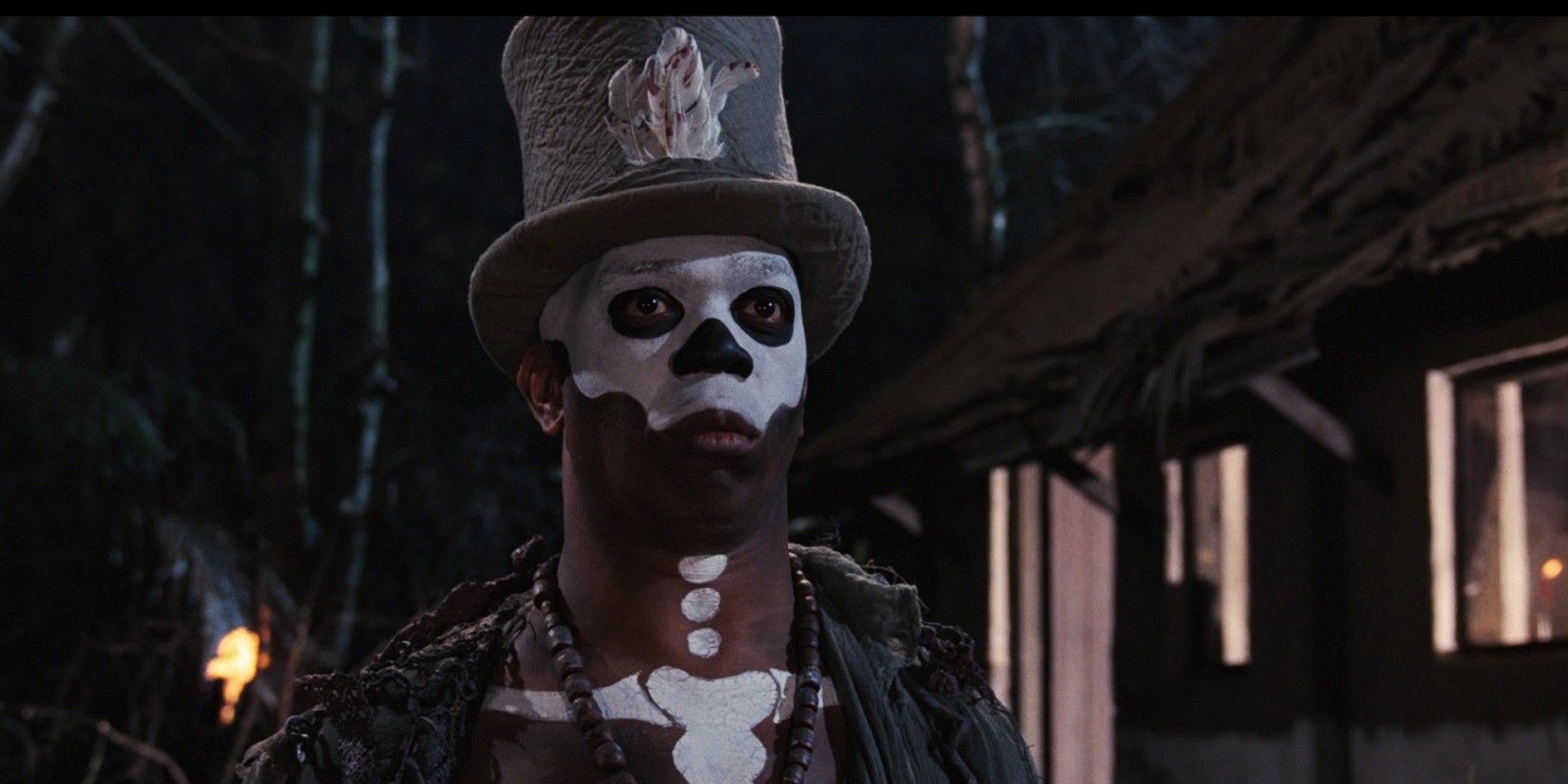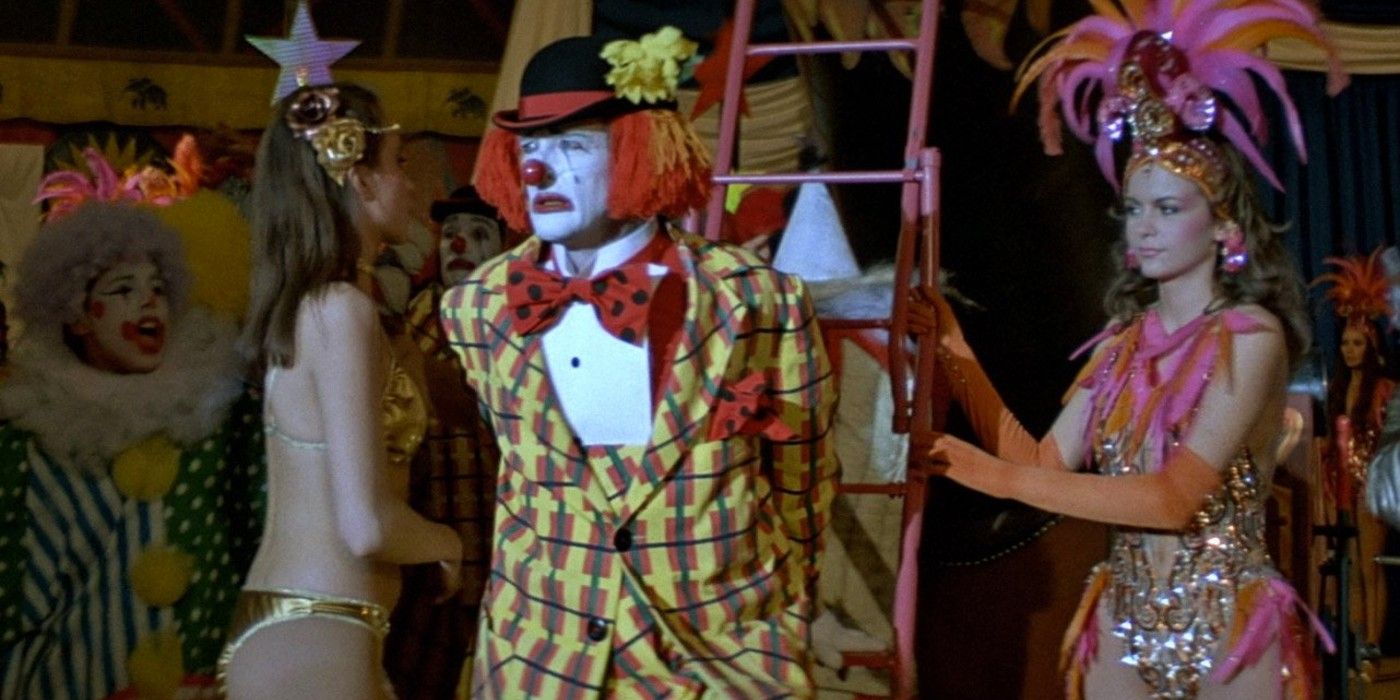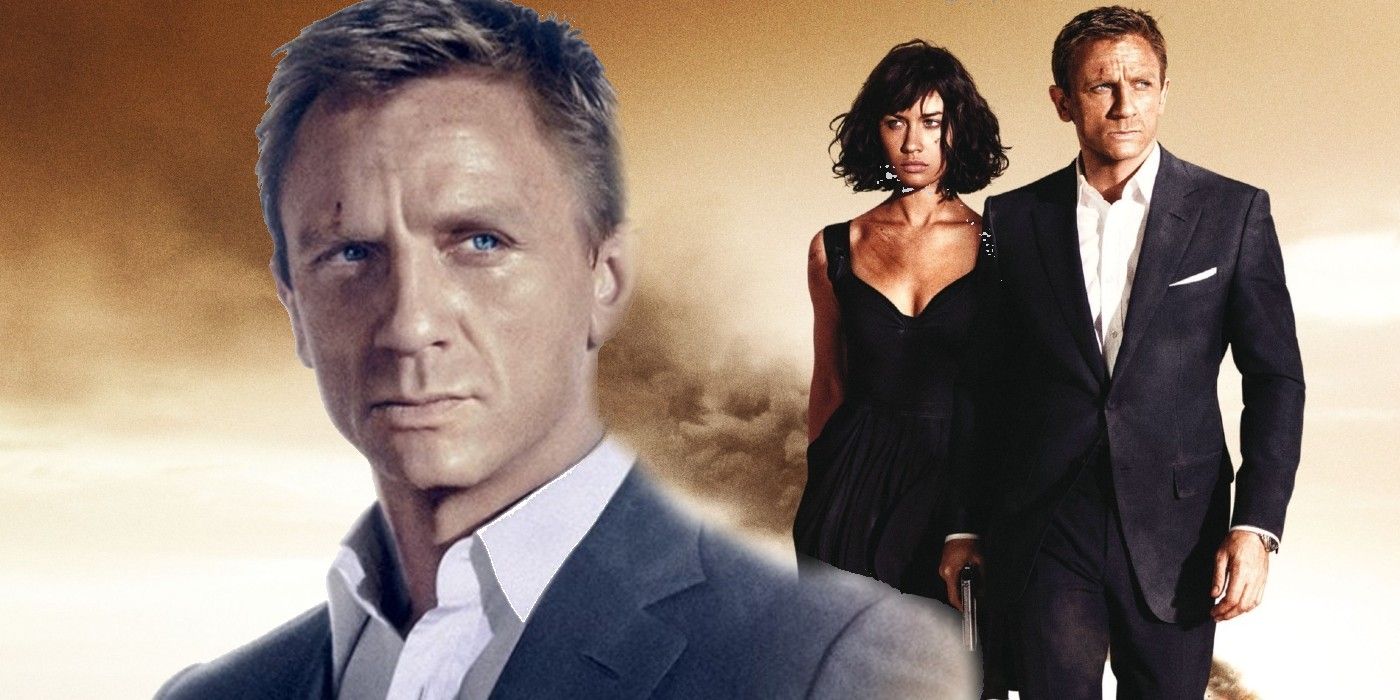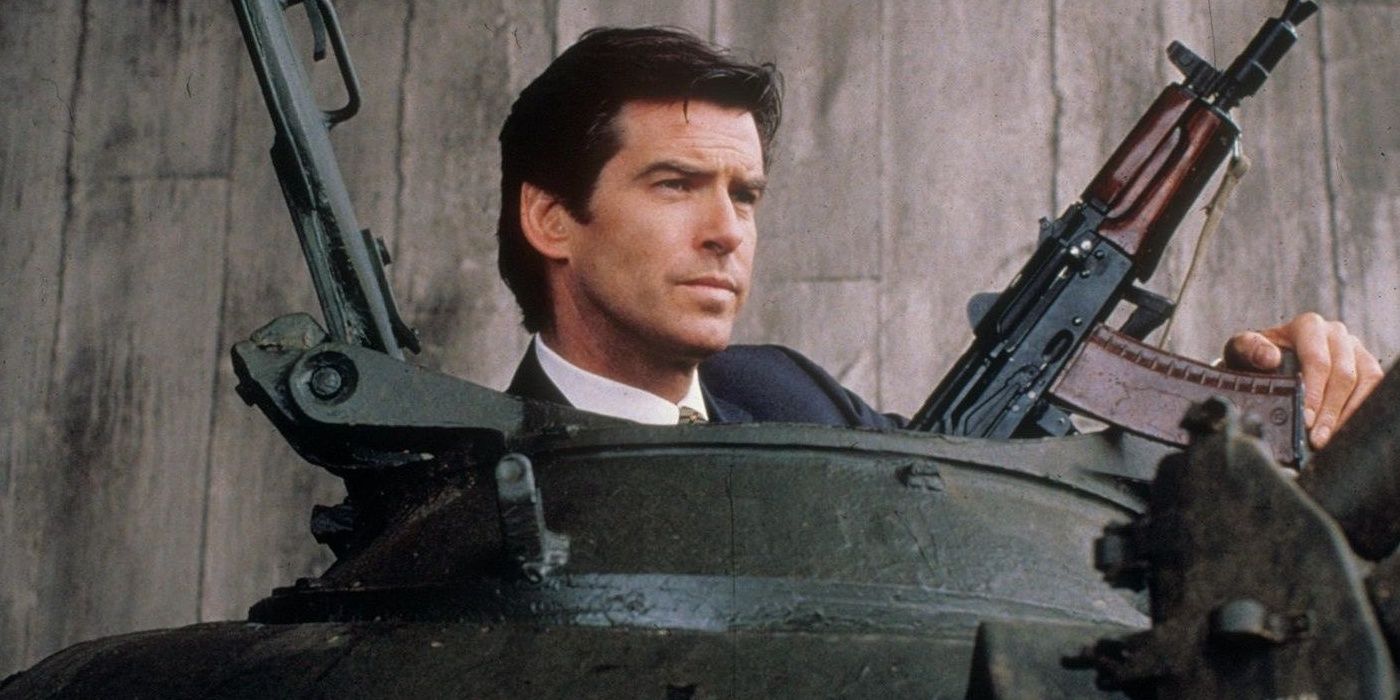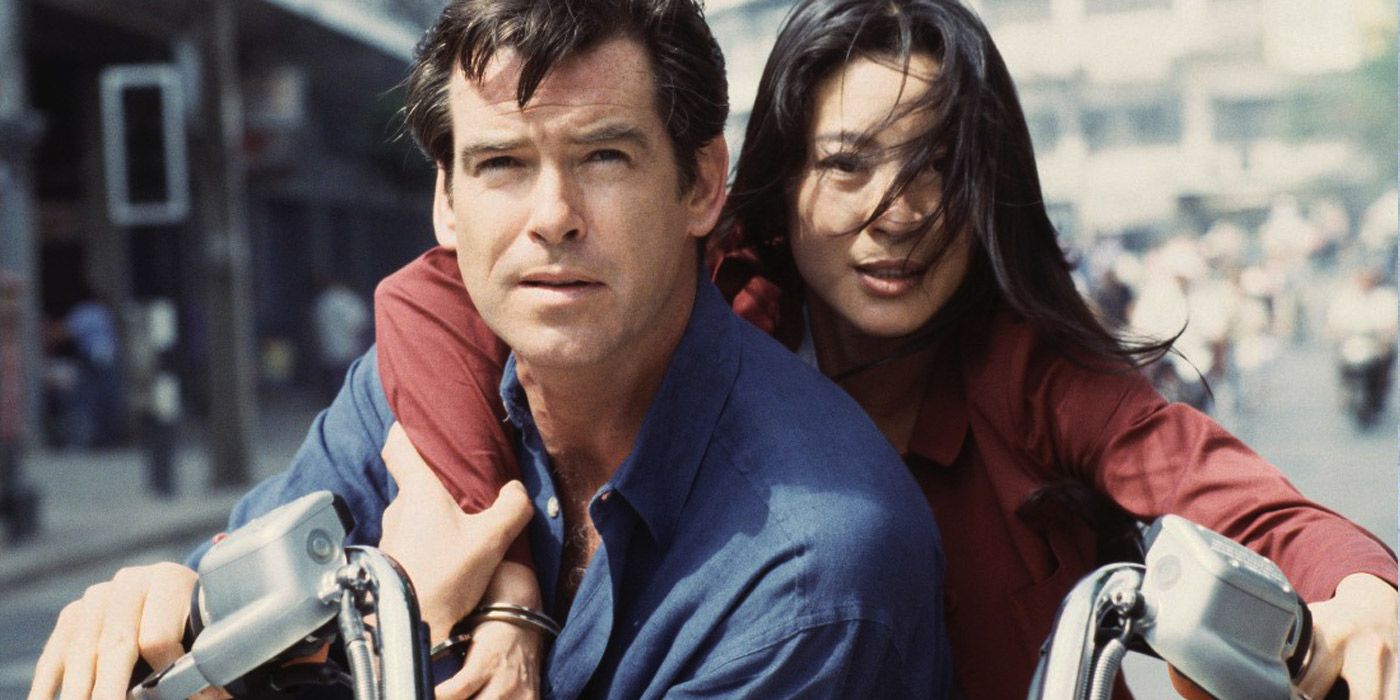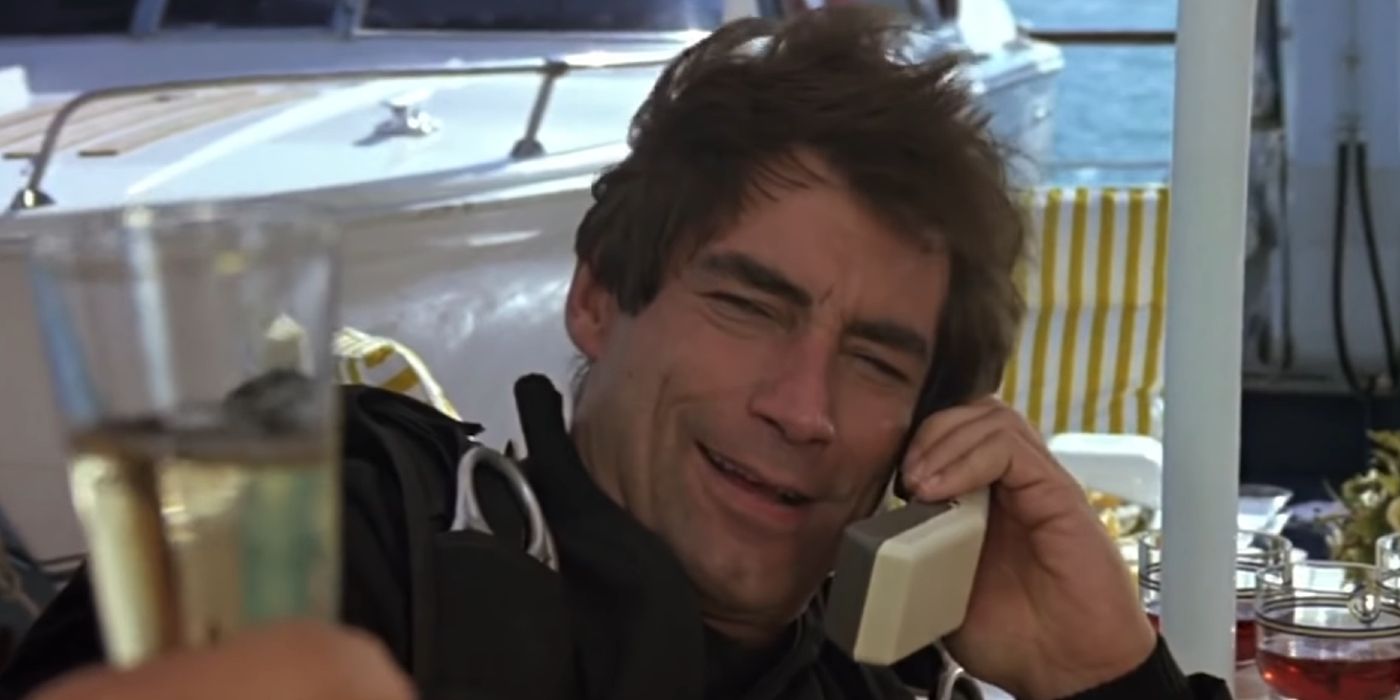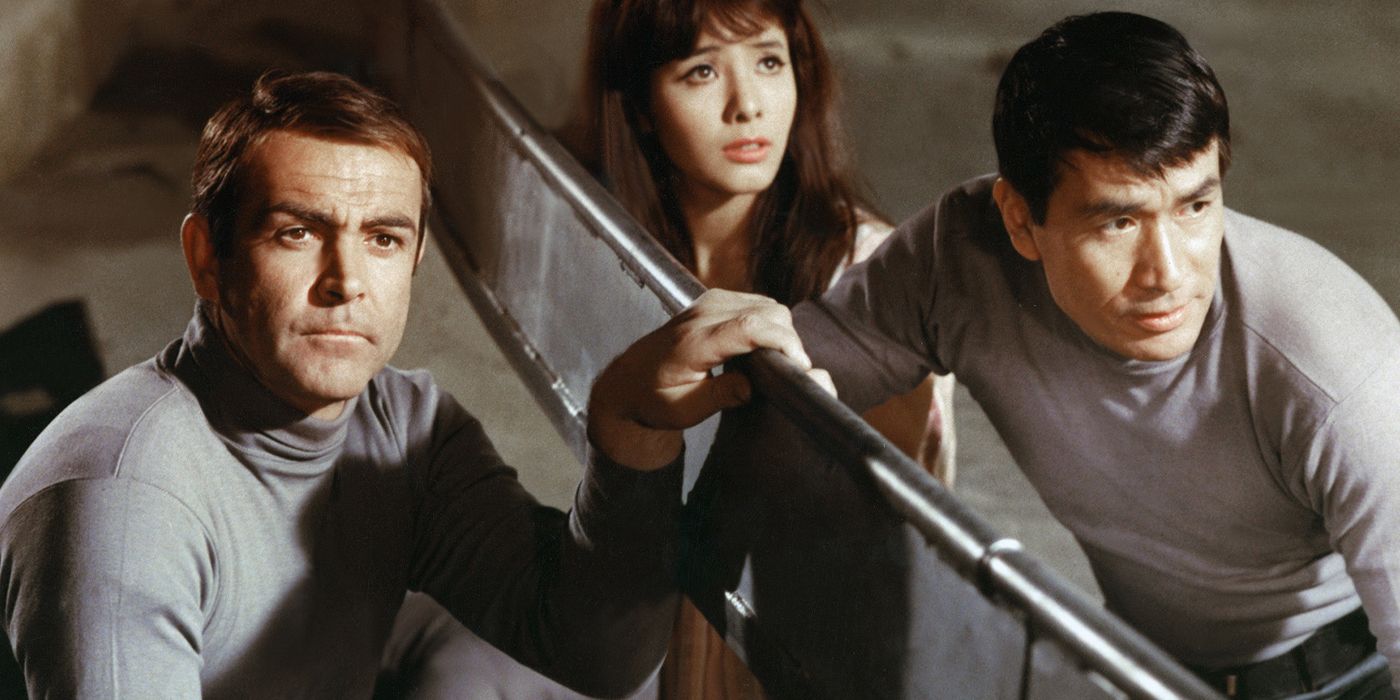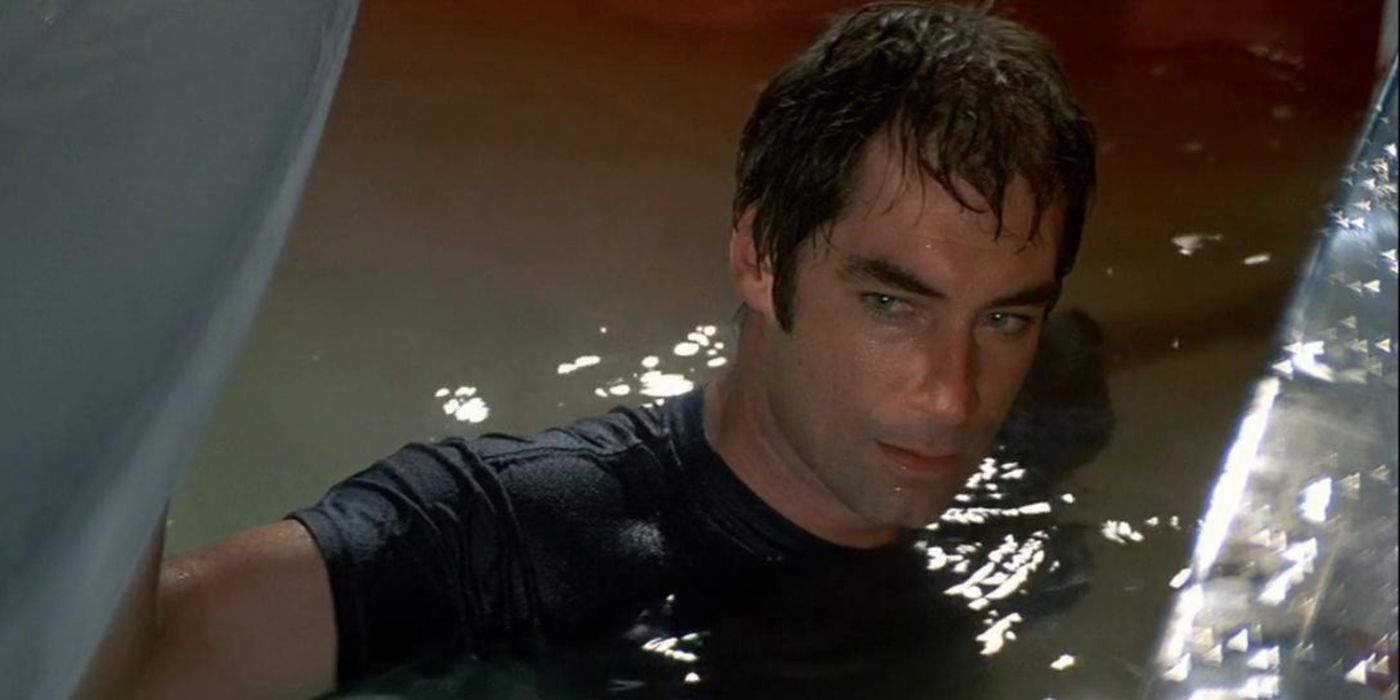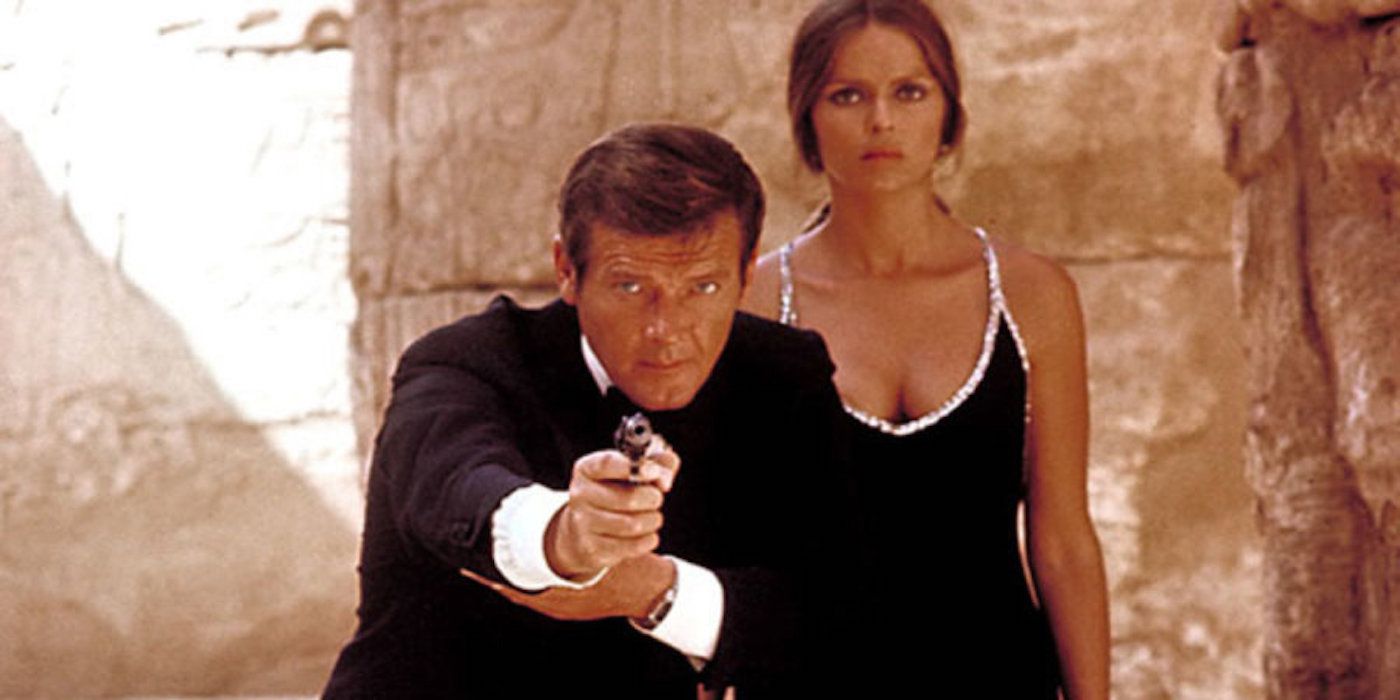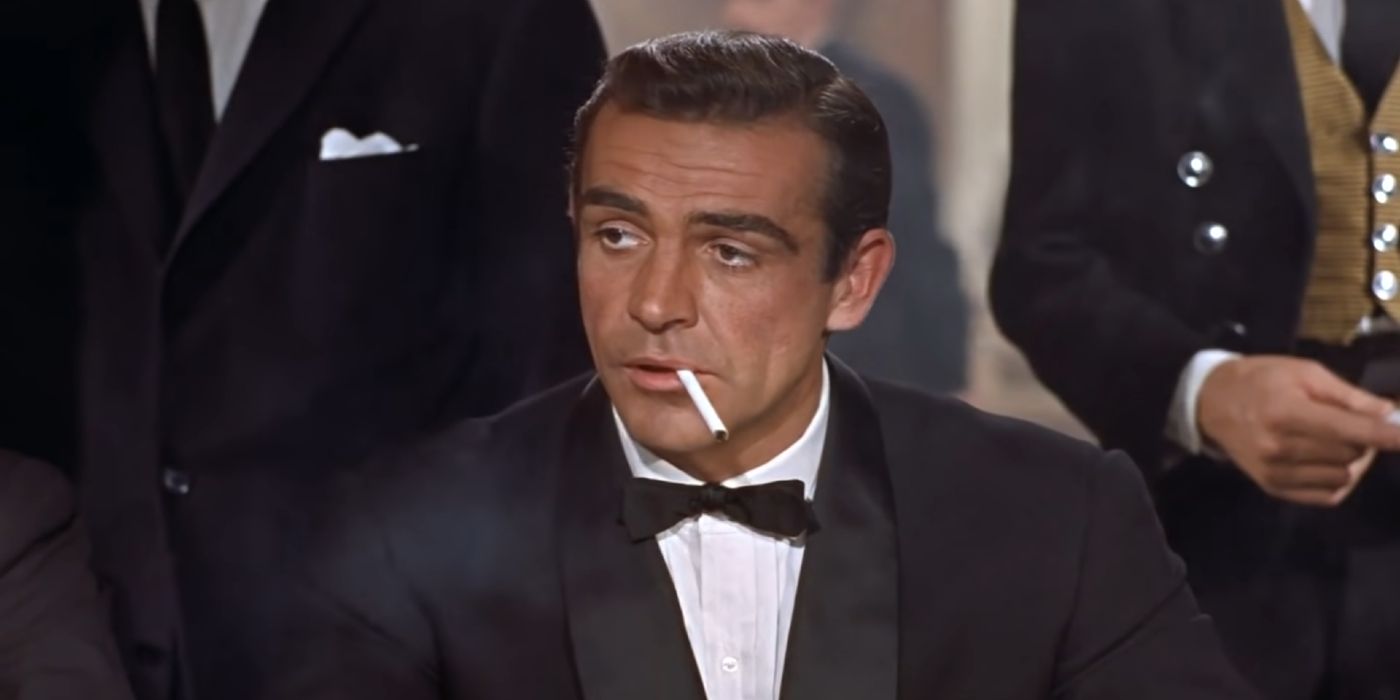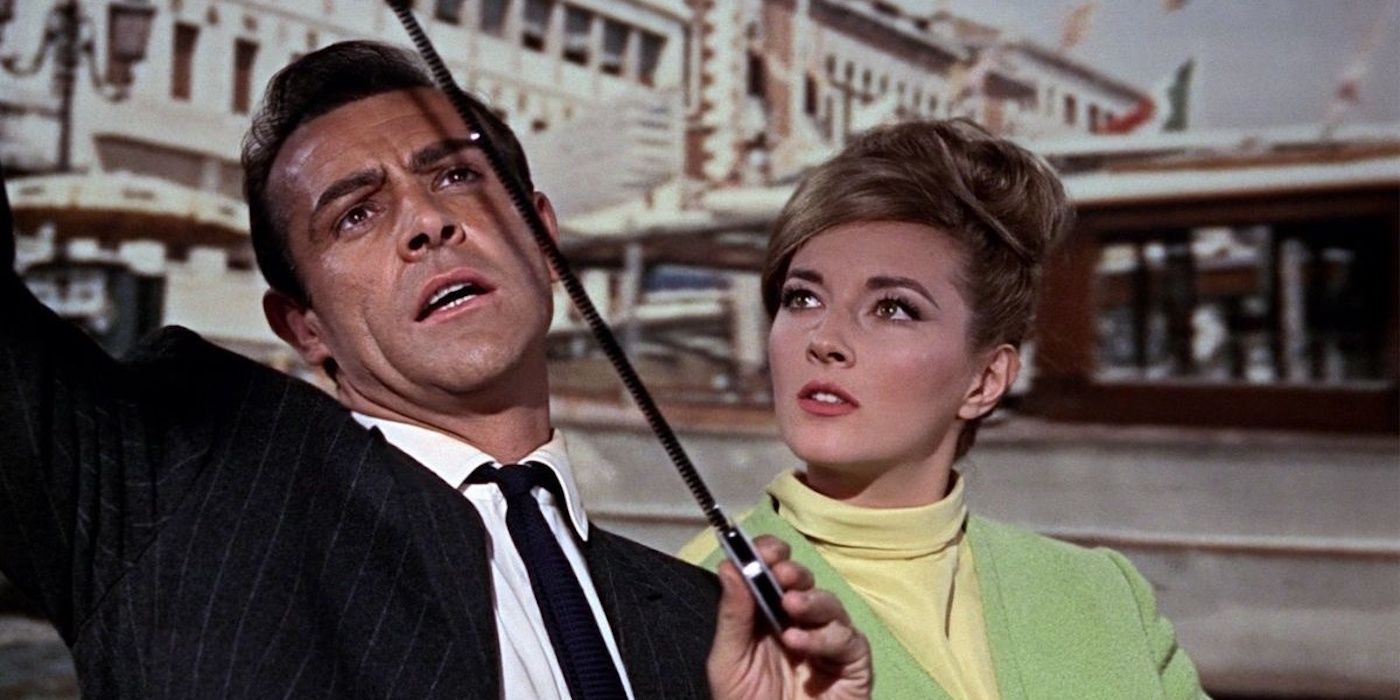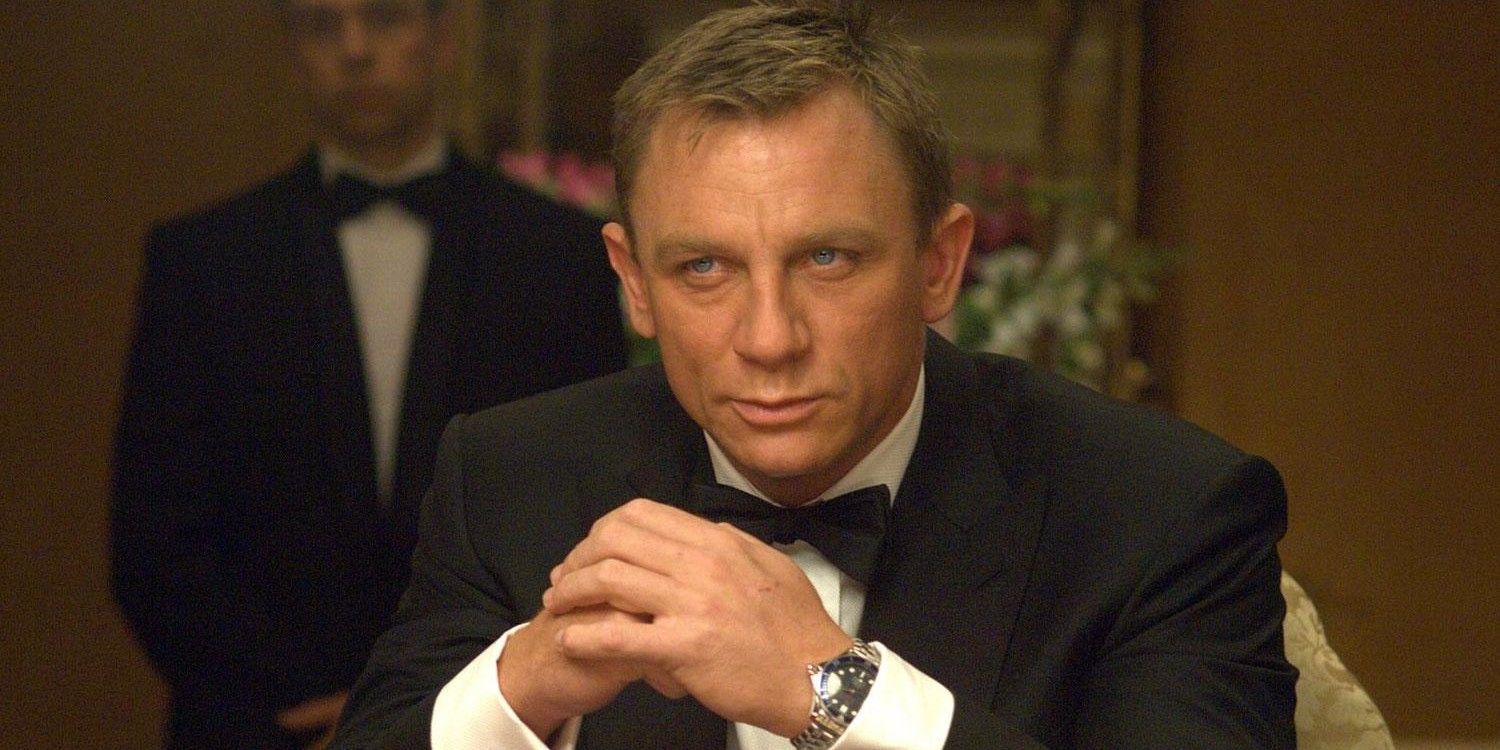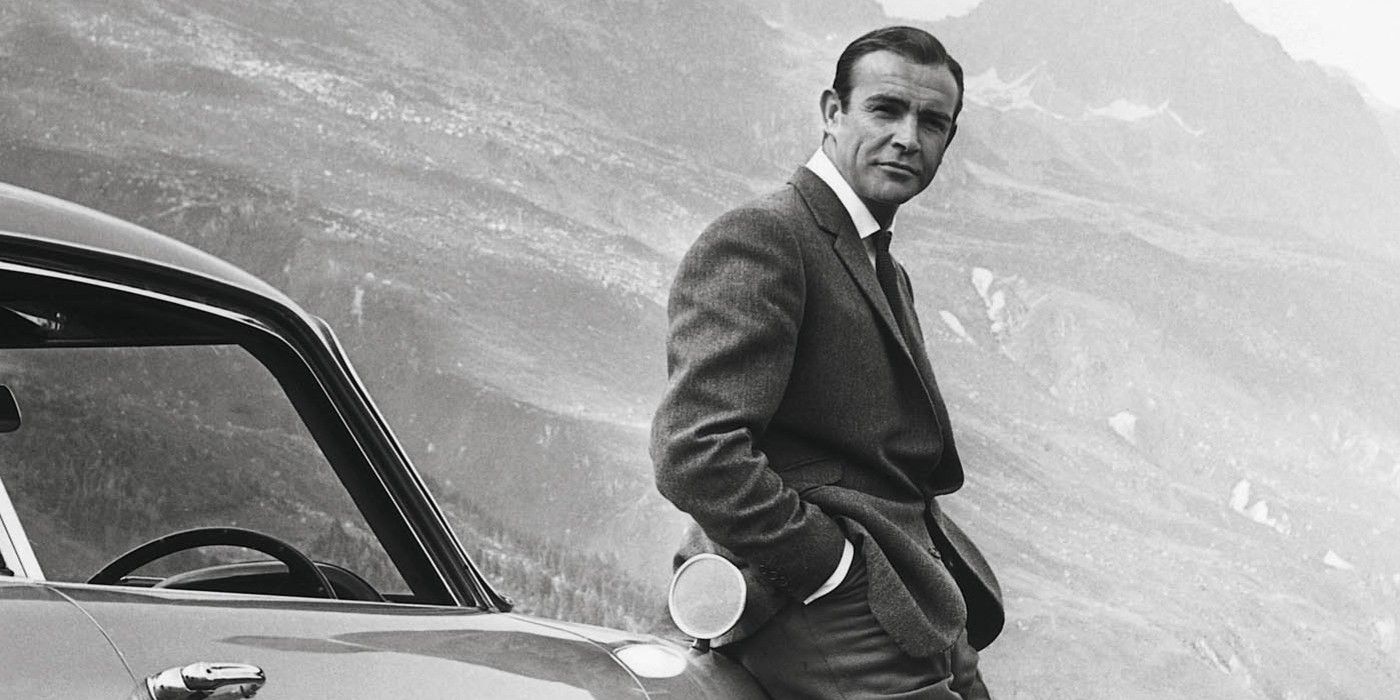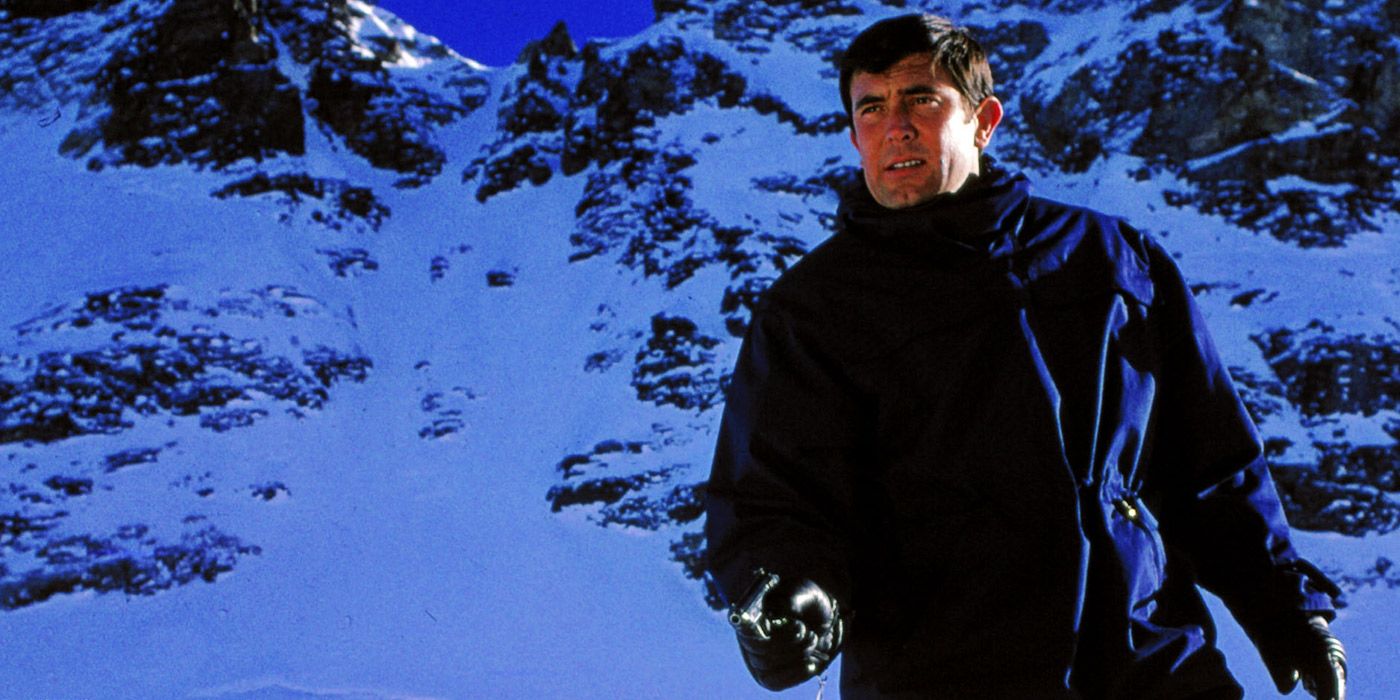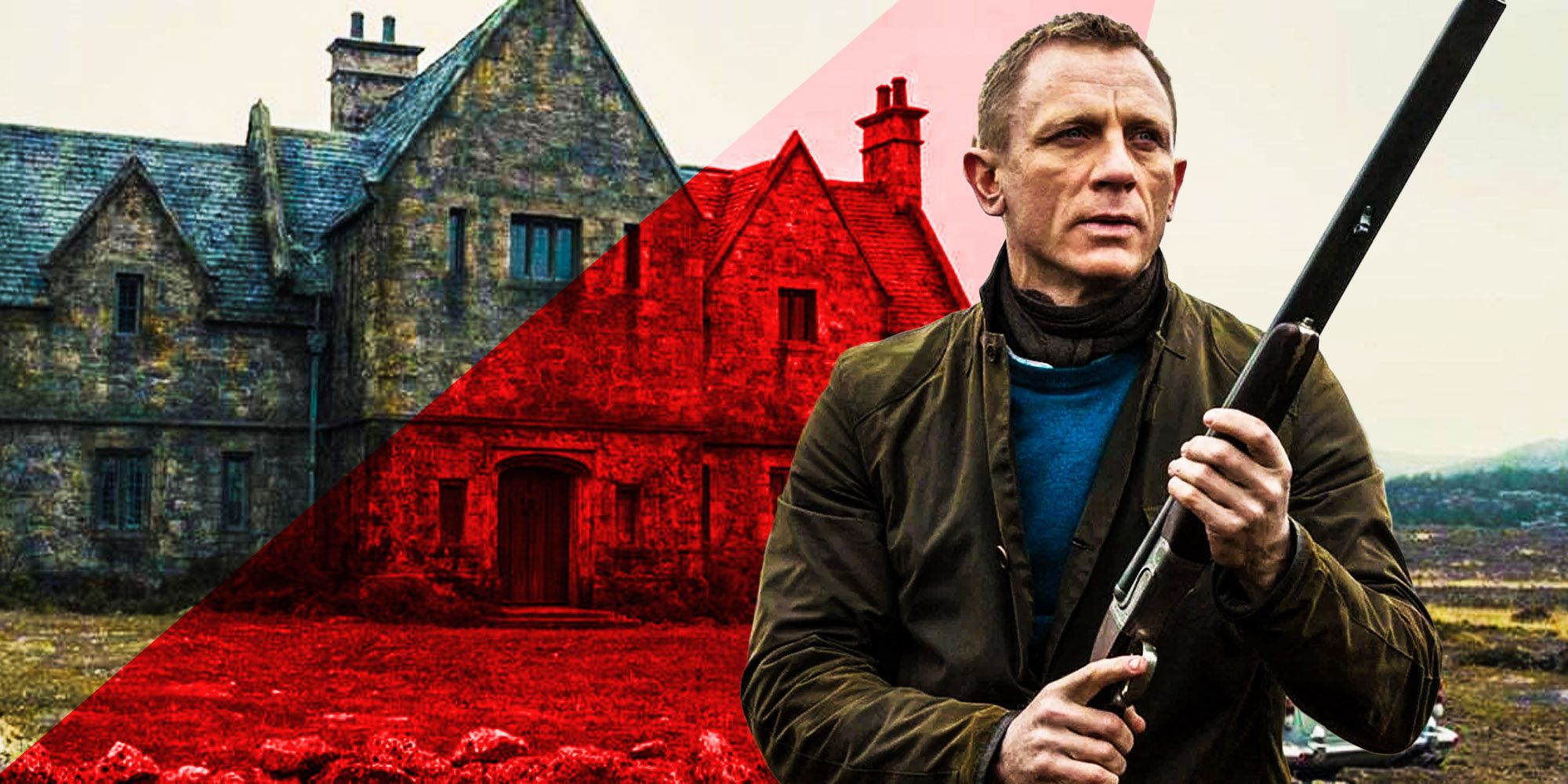After a long delay James Bond is back in No Time to Die, so there's no time like the present to rank his cinematic outings from worst to best. Through six Bond actors, 60 years and 25 movies, Ian Fleming's "blunt instrument" has punched, quipped, and slept his way through a wide variety of adventures in one of the highest-grossing media franchises of all time. Blaring horns, smoking guns, and martinis (shaken, not stirred) have woven themselves into the fabric of cinematic iconography, with the promise "James Bond will return" a constant for multiple generations.
The character first appeared in Fleming's 1953 novel, Casino Royale, which became a hot property for radio and television adaptations. Less than a decade and exactly nine Fleming novels later, Eon Productions (owned by Harry Saltzman and Albert R. "Cubby" Broccoli), acquired the rights to 007 and released the first film in the series, Dr. No. From the moment Sean Connery introduced himself as "Bond, James Bond," a legend was born, and the Scottish actor would go on to reprise the role in five entries before launching the tradition of passing the torch to the next 007. George Lazenby, Roger Moore, Timothy Dalton, Pierce Brosnan, and Daniel Craig have all followed, each giving their own spin on the British secret agent.
For a franchise so reliant on formula, there's a wide variety of types of Bond adventures. Some embrace the ridiculous and some the hard-boiled grit of Fleming's stories. Some attempt to give 007 something resembling a soul, others have invisible cars and jetpacks. A viewer's entry point can set the tone for what they expect from a Bond film and because of that, nearly every title in this ranking is probably someone's favorite. There will be no Never Say Never Again or 1967's Casino Royale featured, and there will also be no spoilers for No Time to Die; these are the 25 official Eon produced Bond films, ranked from worst to best.
25. Die Another Day (2002)
Invaluable to the series only because the film almost killed it so it could be reborn with Casino Royale, the 20th Bond adventure features all of the franchise's worst impulses. For being the entry that brought 007 into the 21st century, this is an incredibly tacky-looking movie, from the community theater ice palace to the CGI wave of melted ice Bond surfs. The filmmakers are lost at sea, piling on the gadgets (including a dream machine and the invisible car) and embracing the sexual innuendoes and one-liners so intensely it feels like a parody of Austin Powers. To witness its overblown climax - set on an exploding plane - is to see James Bond gone wrong, to witness the franchise quite literally self-destruct. Bond may have lived to die another day, but this was a close call.
24. The World is Not Enough (1999)
No Bond film is without its pleasures, but Brosnan's third time comes close. It doesn't help that several elements - 007 being wounded in the opening, a past foe of M's stepping out of the shadows - would all be handled better in Skyfall. Mostly, the movie just feels plodding, both an unfortunate showcase for the series' most adolescent tendencies and an undercooked preview of what it would do with the Craig entries, but this time with the wrong people involved. Sophie Marceau is an intriguing villain, but Robert Carlyle comes off embarrassed playing a terrorist who doesn't feel pain due to a bullet lodged in his head. Meanwhile, Denise Richards lays claim to the title of Worst Bond Girl of All Time.
23. The Man With the Golden Gun (1974)
The Man With the Golden Gun, Roger Moore's second outing as James Bond, isn't just a low point for its star but the series as a whole. It's a nearly joyless affair watching 007 careen from Beirut to Macau, from Hong Kong to an island showdown with the three-nippled hitman Francisco Scaramanga, played by a woefully wasted Christopher Lee. Fantasy Island's Hervé Villechaize is quite literally hung out to dry and there's even a flying car. A headache-inducing theme and an incredible car stunt underscored by a lame slide whistle serve as the perfect embodiments of the film as a whole; this is both an obnoxious bang and a lousy whimper, and one of the worst Bonds yet.
22. Diamonds Are Forever (1971)
Sending Bond to Vegas should lead to firecracker results, but aside from a killer theme sung by Bond chanteuse Shirley Bassey, this is mostly a stinker. Connery returned for a then-record $1.25 million salary after the box office disappointment of George Lazenby's one-and-done On Her Majesty's Secret Service. Overall, it's one of the most stupidly goofy Bonds and has aged poorly. Charles Gray shows up as Blofeld in the final act, but even that appearance devolves into a childish encounter involving a launch crane and a mini submarine, an ignominious ending for Bond's iconic arch-nemesis considering he wouldn't return in earnest until...
21. Spectre (2015)
All Bond movies are reflections of the cinematic landscape in which they're released, so it's not a surprise the MCU's trend of focusing on an over-arching narrative rather than the film at hand would wind up influencing 007. Blofeld has been Thanos-ing long before Josh Brolin snapped his purple fingers, yet his re-emergence here feels hackneyed. That's partly due to the uninspired casting of Christoph Waltz, who could do this type of performance in his sleep. More distressingly his claim to being the "author" of Bond's pain stems from the sort of cynical pandering that would bring Emperor Palpatine back in The Rise of Skywalker. That might all be fine if said reveal didn't follow a plodding, meandering first hour that unsuccessfully mimics Skyfall's "ruined city" existentialism about the state of MI6, itself following a plodding, meandering theme song that unsuccessfully mimics its Adele-sung predecessor. Even a burly brawl between Craig and Dave Bautista on a train feels like a callback to a far superior sequence, in a superior film.
20. For Your Eyes Only (1981)
007 stumbled into the 1980s with this attempt to transplant Moore's Bond into a gritty throwback to the serious-minded thrills of From Russia With Love. Somehow, that attempt still involves an ice rink battle with a hockey team, a bizarre cameo from a Margaret Thatcher impersonator, and an opening confrontation between Bond and an uncredited Blofeld that feels less like a reunion and more like a Tom and Jerry short. There's an intriguing Bond girl in Caroline Bouquet's Melina, who for most of the film is on her own path to avenge the death of her parents, with little sign of being seduced by her leading man. Frustratingly, the screenplay misses the opportunity to bond her and James through their mutual loss of loved ones, a dynamic that might have lent emotion to an otherwise bland entry, particularly with James' deceased wife Tracy given a rare reference in the film's opening moments. Alas, For Your Eyes Only abstains, settling for being what no Bond movie wishes to be; forgettable.
19. A View to a Kill (1985)
Moore's tenure as 007 was mostly notable for its goofiness, but his final film as James Bond is mostly a staid-to-the-point-of-boring affair. There's the occasional oddity - a ski chase scored to the Beach Boys' "California Girls," or a woman in a jacuzzi saying, "The bubbles tickle my Tchaikovsky." Mostly though, View to a Kill, Moore's least favorite Bond, stands out for just how old its star is. The screenplay attempts to compensate for this, saddling him through most of the story with the distinctly un-Bondian task of snooping around ornate homes and horse race events, pretending to be a journalist named James Stock. On the rare occasion he gets up to some action, whether it be a chase up the Eiffel Tower or any number of romantic couplings with younger women, the results alternate from creaky to creepy. Christopher Walken fares better as the sadistic Zorin, and together with Grace Jones' May Day he makes up one of the most dynamic villain duos in the series. Taking that into account, this one also gets a few bonus points for its Golden Gate Bridge finale, and for that bop of a theme.
18. Thunderball (1965)
Were it not for a series of legal disputes beginning shortly after the 1961 publication of Ian Fleming's novel, Thunderball would have been the first entry in the Bond series. Fortunately, that wasn't the case, as after the remarkably sure-footed debut of 1962's Dr. No and the innovations and evolutions of From Russia With Love and Goldfinger, Thunderball feels the most "cruise-control" of the Connery entries. That's partly to do with its inflated running time, the first in the series to exceed two hours. However, as innovative as the sequel's copious use of underwater photography was at the time, it now only adds an element of sluggishness to an unfortunately over-padded, ponderous entry.
17. No Time to Die (2021)
The latest 007 adventure, Daniel Craig's final Bond movie, wants to do a lot in its near-three-hour runtime. It wants to mine the emotion of On Her Majesty's Secret Service, the first outing to give its hero a soul, as evidenced by the callbacks to that entry. It wants to tie up the loose ends of Spectre, a task probably better left alone, but one that eats up nearly half the runtime. It also wants to return to the Bond franchise's most eccentric aspects; island lairs, evil plots for world domination, all the things that never fit well into this era of 007. Most of all, it wants to give Daniel Craig's James Bond, arguably the best 007 of all time and certainly the most dynamic, a proper sendoff, something it achieves once it has the sense to get out of its own way. A cathartic finale is one of the lone standouts here, along with a firecracker cameo from Bond newcomer Ana de Armas and a distinctly un-Bondian prelude. Elsewhere, Rami Malek is a disappointing villain, a COVID-esque plot feels both poorly timed and regressive, and Lashana Lynch's much-buzzed-about new 007 isn't given much to do. The Craig era ends with a solid goodbye to its star, but also one of his most bloated adventures. It's not the annoyance that Spectre was, but the true final Craig film will always be Skyfall.
16. Moonraker (1979)
Often touted as one of the worst entries, Moonraker is at least memorable for its pre-credits skydiving sequence - one of the best stunts in the entire franchise - and for its final act, which improbably sends Bond to space. It's the film's middle hour which is the most difficult to get through, as Bond contends with Michael Lonsdale's villain, Drax, and sleepwalks through a series of uninspired setpieces, most involving Richard Kiel's metal-mouthed Jaws. Here, he's transformed into a Wile E. Coyote-esque doofus. After that tedium, the shark-jumping hijinks of the finale, where Jaws finds love with a pig-tailed blonde and Drax reveals himself to be a Space Nazi are a welcome jolt of energy. Moore's offerings were often guilty of copying the hits of the time, and while the reference here is undoubtedly Star Wars, Ken Adam's production design and the visual effects are undeniably impressive.
15. Live and Let Die (1973)
Moore's first outing is not without its problems. The desire to mimic cinematic trends of the time sees 007 co-opting the Blaxploitation genre for a brief foray that only underlines the character's imperialist sense of superiority over his non-white supporting characters. That's the dated part of a sequel that stands out for its dark voodoo plotline, tarot card-reading Bond girl Solitaire, and for two of the series' more unique villains, Yaphet Kotto's Kananga and Geoffrey Holder's witch doctor Baron Samedi. That it all kicks off with one of the best Bond songs, by Paul McCartney and Wings, is enough to knock it up a few notches.
14. Octopussy (1983)
After five entries flirting with the notion of making a complete mockery of the franchise, Moore finally got to turn James Bond into a literal clown. Octopussy gets a bad rap, not for entirely unjust reasons. It squanders its first act India setting with lame stereotypes that make Temple of Doom feel restrained. There's a Tarzan yell, an incomprehensible plot concerning Fabergé eggs and nuclear holocaust, plus a headscratcher of a moment where Bond seems to recognize his own theme music. Indeed, it's a far cry from the Connery days, often feeling more like bottom-shelf Mel Brooks (Spaceballs) than Bond. As noticeably long in the tooth as he is here, he's also the most alive he ever was in the role, surrounded by a film that plays to his strengths and actually makes him relaxed enough to be an engaging action star. Brush away the ridiculousness and Octopussy boasts an impressive succession of setpieces, from chases via rickshaws and trains to a thrilling, death-defying final plane confrontation that almost justifies the film's awful theme song, "All Time High."
13. Quantum of Solace (2008)
Criticisms that Craig's Bond has lost the franchise's sense of fun are most likely caused by this brutish, lowkey sequel to the triumphant high of Casino Royale. Nonetheless, Quantum of Solace, whatever that means, isn't the series-worst entry some fans claim. It's best viewed as a coda to Casino Royale, one which takes the vengeful Bond girl plot of For Your Eyes Only and the "Bond as angel of death" vibe of the (superior) Licence to Kill, mixing both into the sort of cold-blooded revenge movie that should have followed On Her Majesty's Secret Service. Shot from an unfinished script due to the writer's strike, with some of the dialogue written on the fly by director Marc Forster and Craig himself, this is admittedly not the most cohesive entry. Still, Quantum is at its best when it's focusing on Bond's struggle for inner peace in the wake of Vesper Lynd's death, or on his tug-of-war relationship with his boss (featuring some of Judi Dench's best work as M in the series). It's considerably less effective when dealing with its evil environmentalist bad guy (a waste of an intimidating Mathieu Amalric), or stumbling through its overly edited action sequences. Daniel Craig makes it all worthwhile, navigating Bond's journey beautifully from wounded, vengeful lover to cold MI6 assassin.
12. GoldenEye (1995)
The 007 films have always been reactionary, both to cinematic trends and to the public perception of whichever adventure Bond underwent last. It's no surprise that after two grittier entries and a six-year hiatus, the franchise would come roaring back to life with a desire to please every kind of Bond fan at once. In that way, GoldenEye can be frustratingly regressive, both in its Soviet-centered plot and in the type of megalomaniacal villain plan that felt tired several entries ago. Taken on its own terms as a sort of "greatest hits" Bond film, it's plenty of fun, with Pierce Brosnan's suave 007 serving as a solid cocktail of Dalton, Moore and Connery. There's nothing new or bold about his performance, but also nothing offensive. The only real innovative, tantalizing aspect of this entry is the introduction of Judi Dench as M, who - despite a brief appearance - makes a big impression, setting up the maternal-meets-adversarial relationship with Bond she would develop further in the Craig era. Other than that, this is mostly a splashy toy commercial of a film, exactly the kind of action flick in which the '90s specialized.
11. Tomorrow Never Dies (1997)
In 1997, Tomorrow Never Dies got roundly beaten by Titanic at the box office - but that doesn't mean Brosnan's second Bond adventure is worthy of derision. After the balls-to-the-wall brouhaha of GoldenEye, this one feels a bit more refreshingly relaxed and in control. Its plot, which concerns a Murdoch-esque media magnate played by Jonathan Pryce (The Wife), whose evil plan is to sow mass chaos to achieve - of all things - exclusive broadcasting rights in China for 100 years, is certainly among the series' more ridiculous. However, it's also the rare Brosnan film that looked at the present rather than the past, eschewing Cold War conflict for a satire on the evils of the day, exactly the sort of thing the series was doing in its earlier entries. That's to say nothing of Brosnan's chemistry with Michelle Yeoh, certainly in the upper echelon of "Bond-and-Bond-girl dynamics," nor of Vincent Schiavelli's scene-stealing Dr. Kaufman, one of the series' most genuinely funny villains.
10. The Living Daylights (1987)
Contemporary audiences didn't quite know what to make of this entry's willful contrast to the Roger Moore Bond era, but nowadays, it feels like a breath of fresh air to see Bond actually break a sweat. The Living Daylights is the first entry since From Russia With Love to successfully get back to the meat-and-potatoes espionage and adventure of Fleming's source material, with Timothy Dalton's Bond a nervy combination of debonair and dangerous that has largely gone undervalued in evaluations of the series. At times, his first outing can feel like a Bond film in name only, tamping down not only the character's sex appeal but also the franchise's reliance on gadgets, diabolical villains or one-liners. Nevertheless, despite a sometimes frustrating lack of humor, this is Bond at some of his leanest and meanest.
9. You Only Live Twice (1967)
The less said about a late-game plot point in this installment which has Connery donning yellow-face to disguise himself as a Japanese fisherman, the better. That ill-conceived moment aside, You Only Live Twice - adapted from one of Fleming's darker novels - is all about Little Nellie (one of Q's most satisfying gadgets) and a finale that unveils both production designer Ken Adam's best set, a hollowed-out volcano lair, and the pivotal moment when Bond's arch-nemesis Ernst Stavro Blofeld first steps out of the shadows. Played here by Donald Pleasance in the character's first and greatest appearance, the short-lived but unforgettable performance created an evocative capitalization on the mystery surrounding 007's arch-villain, one whose absence would linger over most of the subsequent films. The final setpiece is a real barnstormer, with Roald Dahl's screenplay ushering in a new era of eccentric gadgets and villains for the hero.
8. Licence to Kill (1989)
If there's one entry in the Bond franchise that benefits from a marathon of the series, it's Licence to Kill. In a basket of oranges, this stands out as the poisoned apple of the bunch, an impressively daring follow-up to Dalton's already bold debut. Its plot begins a bit too ugly, with implied rape and dismemberment all being dished out in the first act. Soon, though, it settles into the sort of personal revenge thriller that should have followed On Her Majesty's Secret Service. As it stands here the final Dalton outing, which sees Bond suspended and striking out on his own is one of the series' most satisfyingly different. This entry eschews the typical aesthetics of the franchise, delving instead into the obsessive tenacity of a dangerous man who's lost one too many loved ones. Dalton really stakes his claim as the most under-celebrated 007 here; sure, he paints the character at his most hard-edged, but there's an aspect he brings to the character that never really existed before - genuine warmth. That quality is evident in his romance with Carey Lowell's Bond girl and in his rapport with Desmond Llewelyn's Q, who gets some enjoyable time in the field here. It all culminates with a rough and rowdy oil tanker showdown, and one of the most satisfying villain deaths in the series.
7. The Spy Who Loved Me (1977)
It all starts with that stellar opening stunt, then in comes the schmaltzy piano intro from Marvin Hamlisch's "Nobody Does It Better," hands-down the most swoony and romantic of all the Bond themes. From there, it's mostly smooth sailing through what is arguably one of the most important entries of the entire franchise. Fortunately, the film functions as a return to form following Moore's last outing, largely thanks to the re-hiring of You Only Live Twice director Lewis Gilbert and series' MVP Ken Adam, whose production design outdoes itself with the final act's giant supertanker set. Ultimately, this adventure is a success because it gives Moore, always capable of playing a darker James Bond, constant conflict from his supporting cast. That's the case with Barbara Bach's Major Anya, whose uneasy alliance with 007 gives the story a crackling sense of tension.
6. Dr. No (1962)
From 007's punny quips to that iconic Monty Norman theme, it's incredible how much of the Bond aesthetic arrives fully formed in Dr. No. Of course, the greatest victory of all is the casting of Sean Connery, who crystallizes the sexy swagger, tongue-in-cheek sense of humor, and vicious danger of the spy right from his entrance. The series would expand with more scope and spectacle in subsequent films, but this is still one of the more tautly engaging entries, with its fair share of eye candy, from Adam's expansive sets to Ursula Andress' famed emergence from the Caribbean Sea in a white bikini.
5. From Russia With Love (1963)
One of the best sequels ever made (and Connery's, Dalton's, and Craig's favorite entry in the series), From Russia With Love is less a follow-up to Dr. No as it is an alternate take on what a Bond film can be. Less jokey and more of a Cold War spy thriller, the hard-boiled grit of this entry wouldn't be seen again until Timothy Dalton and Daniel Craig resurrected it. Connery is perfection, with a superb Bond girl in Daniela Bianchi and two series best villains in Lotte Lenya and Robert Shaw. The eleventh hour Hitchcockian train fight with Shaw still ranks as one of the best action sequences in any Bond outing, capping off a film that's 007 at its best. From Russia With Love's formula of pulpy mystery, sensuality, globe-trotting, gadgetry, and movie star machismo has rarely been bettered.
4. Casino Royale (2006)
One of the many pleasures of a Bond rewatch is to experience the effect of how much of a pivot Casino Royale was for the series. It's essentially a two-hour and 20 minute-long mic drop, the kickoff of the finest run the series has experienced since the Connery era. There was much resistance to Daniel Craig's casting, from his blond hair and blue eyes to his gruff, brooding demeanor. His Bond is without a doubt a gorilla of a man, leaping off scaffolding and propelling himself up with his tree-trunk arms, but the first hour embraces this fully with the kind of scrappy and brutish action beats, no doubt inspired by Jason Bourne, that simply doesn't exist in studio films with this budget level. By the time he's taken to the poker table, viewers are primed for a total reinvention and one that seamlessly melds the martinis, tailored tuxes, and dry witticisms they know and love with moments of genuine introspection. Dench's M finally gets some solid material and a sparring partner in Craig worth her weight, while Mads Mikkelsen's blood-weeping baddie is a nice tip of the hat to the quirky villains of old.
3. Goldfinger (1964)
Three movies in, Bond reached a perfect synthesis of the straight-faced silliness of Dr. No and the ultra-cool spy thriller of From Russia With Love. Goldfinger is the defining film of the Bond franchise for myriad reasons, from its increased use of gadgets to its often-imitated-but-never-equaled theme song. Its villain Goldfinger is the quintessential 007 baddie, with Oddjob one of the most beloved heavies. There's the Aston Martin, a bevy of memorable Ken Adam sets, and a Bond girl in Pussy Galore who straddles the line between having her own agenda and being seduced by her leading man. When that man is Sean Connery, it's hard to deny. In his third time in the role, he's as perfect a fit as a tailored tux from Saville Row, cementing his 007 as one of the most definitive movie star performances in history, and anchoring the series' most wholly entertaining offering.
2. On Her Majesty's Secret Service (1969)
Famed film critic Leonard Maltin once said that, if Connery weren't recast in On Her Majesty's Secret Service, it would be the best of the Bond films. While it does feel strange to heap such praise on the film starring the only actor to play 007 just once, George Lazenby is also the best agent for this particular job. Sure, he flubs quips Connery would have knocked out of the park, but those asides also feel out of place in a film that is the most human in the series. Bond's coupling with Diana Rigg's Tracy gives the franchise a genuine love story, as well as its most tragic punch. Not only does the shattering ending teach Bond why he can never really be human; it also shows why the series, beyond economical reasons, is doomed to go on forever. Lest the promise of romance and tragedy deter casual fans, rest assured the back half is a parade of thrilling action, with the battle between Bond and Blofeld (Telly Savalas here) given its most raw, personal treatment. That's to say nothing of Michael Reed's cinematography (matched only by Deakins' work on Skyfall), nor of John Barry's doom-laden electronic score, which boasts Louis Armstrong's heartbreaking "We Have All the Time in the World" and the only instrumental theme which ever dared go toe-to-toe with Monty Norman's original. On Her Majesty's Secret Service may be a very different Bond adventure, but it's also one of the best cinematic offerings the franchise has given viewers thus far.
1. Skyfall (2012)
The James Bond series has always been about aging; it just was never acknowledged. For Sean Connery and Roger Moore, it was business as usual in their final outings. Despite graying hair and wrinkled faces, they fired off one-liners, slipped into bed with significantly younger women and left the big stunts to their doubles. There's no hiding that with Skyfall, which action and twists aside is entirely about old dogs, antiquated relics of a bygone era and about whether or not the world needs Bond anymore. That's a valid question to ask after 50 years of movies, but director Sam Mendes manages to answer with a firm, "More than ever." This is that rarest of things, a well-made, thoughtful, and gorgeous looking (thanks to cinematographer Roger Deakins) action film, one that boils the entire series down to its simplest pieces of iconography, trusting its emotional center to what has been its most dynamic relationship for a while now; Craig's Bond and Dench's M. Dench turns in awards-worthy work, as does Javier Bardem as Silva, the cyber-terrorist who would sow the seeds of distrust in M for Bond. Skyfall is the complete package - a satisfying mixture of the old and the new, both a celebration and reflection of all things 007. James Bond will continue to return beyond No Time To Die, but it'll be difficult for the franchise to ever find as perfect a final resting place as Skyfall.

